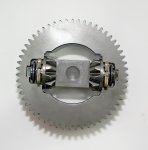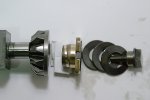Some advice to others. If you plan to take the plunge and rebuild your hst:
RULE1: 1st snatch out trans and disassemble.
Clean parts and l
check for damaged and worn parts before ordering rebuild kit. Also ask questions and take note of parts included in rebuild kit.
Sounds like common sense huh? Well, in my excitement and sense of urgency,
I violated RULE1. After disassembly, while cleaning parts, I found other parts; some worn and some prolly damaged by metal shavings not caught by the magnet (and my failure to change oil). Now, cost of rebuild approaching cost of new trans. More that a used one if I could have found one. Haven't decided what to do. Try and return the parts I have ordered and keep looking for used hst or bite bullet and buy new one if I can find one, or order other parts and continue. :mur:
May soon have 98 Broadmoor for sale cheap (with several bullet holes and baseball bat damage, specifically on hst. It's getting so late in the season and my lawn looks like sh__ anyway (like a hay field) so I have a little time if my neighbors don't evict me. Please request no pics of lawn.
Now for some better news. Remember my prob with the spider gears and how they were mounted? I heard from Simplicity on how to set those gears. This may help others if they decide to tackle this rebuild. Validates what my dealer said and a little better/more information. Here is the response I received:
Hello,
Unfortunately, there is no specific spec for those pinion gears & bolts. What we were told was that they turn the gears, measuring the resistance & tighten the bolts until they achieved the torque value they wanted. The resistance with the gears may be the same, but the bolt torque may not be. That would account for the difference in the belleville washers.
What we do know, is what we should have once everything is done & can work it backwards from there.
When everything is assembled & the differential gear is held (parking brake on with trans assembled) there should be 20 30 ft lbs of resistance. Suggestion is to assemble things (just the differential assembly) & clamp the final drive gear, then put a torque wrench on the axle with a key & socket so you can rotate it & measure the torque you read. You might have to do it several times to achieve what it was, but if you do it that way, you値l end up with it where it was & should be.




